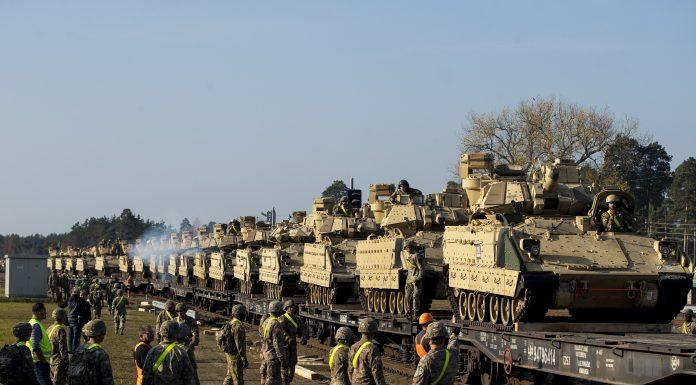(Ken Silva, Headline USA) Senior Biden administration officials have refused to say whether the Bradley fighting vehicles being sent to Ukraine are equipped with ammunition coated in depleted uranium—an extremely dense material that can help ammo pierce tank armor, but which has also been linked to cancer and birth defects.
According to the transcript released Wednesday from a White House “background press call,” a senior administration official refused to answer a reporter’s question about the use of depleted uranium in Ukraine.
“I’m not going to get into the technical specifics,” an unnamed “senior administration official” said twice in response to questions on the matter, according to the transcript.
The Biden White House’s silence on the matter comes as Russia warns that it will treat the use of uranium-coated weaponry as akin to deploying “dirty nuclear bombs against Russia.”
“We are aware that the Leopard 2 tank, as well as the Bradley and Marder infantry fighting vehicles, are armed with sub-caliber armor-piercing shells with uranium cores, the use of which leads to contamination of the area, as it happened in Yugoslavia and Iraq,” Konstantin Gavrilov, the head of the Russian delegation in Vienna, reportedly said Wednesday.
“If Kyiv is supplied with such shells for NATO heavy military equipment, we will consider it to be the use of dirty nuclear bombs against Russia with all the ensuing consequences.”
Depleted uranium-coated ammo was first used in combat in Iraq, where an estimated 1 million rounds were shot during the first Gulf War. They were again used in the 2003 invasion of Iraq, as well as in 2015 in Syria.
The U.S. Department of Defense says depleted uranium can possibly have deleterious effects such as kidney damage, but claims that “no human cancer of any type has been seen as a result of exposure to either natural or depleted uranium.” However, the DOD’s claim has been strongly disputed in scientific studies and other by organizations—including the Italian government, which has found higher cancer rates among its troops deployed to the Balkans in the 1990s.
Historian Wendy Painting’s biography of Oklahoma City bomber and Gulf War veteran Timothy McVeigh chronicles the disastrous consequences depleted uranium had on McVeigh, his cohorts and the citizens caught up in that war.
“The Allies’ use of depleted uranium on tank armor and artillery shells and their bombing or Iraqi weapons facilities had released even more chemicals in the atmosphere. McVeigh’s division was among the thousands of U.S. troops exposed to [depleted uranium], whose effects, after one hour of exposure, scientists equated to fifty chest x-rays,” says Painting’s book, Aberration in the Heartland of the Real: The Secret Lives of Timothy McVeigh.
“A British Atomic Energy Authority report leaked to the Independent in November 1991, said that when coalitions troops existed the Gulf, they left enough [depleted uranium] behind to cause at least 500,000 cancer-related deaths.”
Painting also described the gruesome outcome of a U.S. solider who fell victim to a depleted uranium-covered bullet in a “friendly fire” incident. The solider was a gunner on a M1A1 Abrams tank hit with a sabot round, or ‘Silver Bullet,’ coated with depleted uranium.
“The sabot ignited a fire in Applegate’s tank that burned for two days. Army officials thought his body had been sucked through a three-inch vacuum created by the round,” Painting wrote.
“‘The coffin didn’t weigh anything. I wondered if Tony was really in there,’” the soldier’s widow said, according to Painting. “The only portion of his body in the casket turned out to be a charred hipbone.”
According to Painting, the Clinton administration publicly acknowledged in June 1993 that the depleted uranium used on U.S. tanks and artillery shells may have contributed to the growing number of Gulf War veterans displaying symptoms related to “Gulf War Syndrome”—a term used to describe the raft of negative health symptoms experienced by military veterans from both sides of that war.
Ken Silva is a staff writer at Headline USA. Follow him at twitter.com/jd_cashless.

